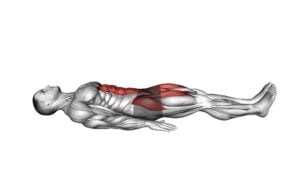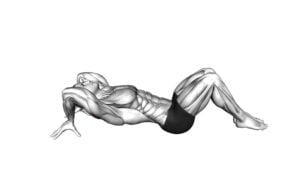Lying Reverse Leg Extension (male) – Video Exercise Guide & Tips

Are you looking for a challenging lower body exercise that targets your glutes and hamstrings? Look no further than the lying reverse leg extension.
Watch This Exercise Video
This video exercise guide will show you the proper form and technique to get the most out of this exercise. With variations and modifications available, you can customize the workout to your fitness level.
Get ready to strengthen and tone your legs with this effective exercise. Let's get started!
Key Takeaways
- Lying Reverse Leg Extension targets glutes and hamstrings.
- It strengthens and tones the lower body.
- Lying Reverse Leg Extension improves athletic performance.
- It isolates the hamstrings and glutes.
Benefits of Lying Reverse Leg Extension
Experience the impressive benefits of the lying reverse leg extension exercise. This exercise offers a range of advantages and delivers great results. By targeting the hamstrings and glutes, it helps to strengthen and tone these key muscle groups. The lying reverse leg extension is a highly effective exercise for building lower body strength and improving overall athletic performance.
One of the main advantages of this exercise is its ability to isolate the hamstrings and glutes. By lying on your stomach and extending your legs backward, you specifically target these muscles, engaging them fully with each repetition. This focused activation helps to develop strong, toned hamstrings and glutes, which can enhance your athletic performance, increase your power and speed, and improve your overall lower body strength.
Additionally, the lying reverse leg extension provides excellent results in terms of muscle hypertrophy. As you perform this exercise, your hamstrings and glutes are subjected to constant tension, which stimulates muscle growth. Over time, this can lead to increased muscle mass and definition in these areas, giving your lower body a more sculpted appearance.
Equipment Needed for Lying Reverse Leg Extension
To perform the lying reverse leg extension exercise, you'll need minimal equipment. Here are the three items you'll need to effectively execute this exercise:
- Exercise Mat: A thick exercise mat will provide you with a comfortable and supportive surface to lie on. It will cushion your body and protect your back from any discomfort or strain during the exercise.
- Ankle Weights: Adding ankle weights to this exercise can increase the resistance and intensity, helping to strengthen and tone your leg muscles even more. Start with lighter weights and gradually increase as you progress.
- Resistance Band: A resistance band can be used to add extra resistance to the exercise, targeting your leg muscles and making the movement more challenging. It can also help improve flexibility and stability in your legs.
When it comes to technique, it's important to maintain proper form throughout the exercise. Start by lying flat on your stomach on the exercise mat. Place the ankle weights around your ankles and wrap the resistance band around your feet, holding the ends firmly in your hands. Slowly lift your legs off the ground, squeezing your glutes and hamstrings. Pause briefly at the top, then lower your legs back down to the starting position. Repeat for the desired number of repetitions.
Proper Form and Technique for Lying Reverse Leg Extension
To ensure proper form and technique for the lying reverse leg extension, it's crucial that you focus on maintaining a strong core and controlled movements throughout the exercise. This exercise primarily targets your glutes, hamstrings, and lower back muscles.
To perform the lying reverse leg extension correctly, start by lying face down on a mat or bench. Keep your legs fully extended and your toes pointed towards the ground. Place your arms by your sides, with your palms facing down.
To begin the movement, engage your core and squeeze your glutes as you lift both legs off the ground. Your legs should remain straight throughout the exercise. Lift your legs until they're in line with your hips, and then slowly lower them back down to the starting position.
Common mistakes to avoid include using momentum to lift your legs, arching your back, or allowing your legs to bend. Remember to maintain control and focus on contracting the targeted muscles.
Variations and Modifications of Lying Reverse Leg Extension
To enhance the effectiveness of the lying reverse leg extension, you can incorporate variations and modifications into your workout routine. Here are three advanced variations and different leg positions you can try:
- Single-leg reverse leg extension: Instead of using both legs, perform the exercise with one leg at a time. This will increase the intensity and challenge your stability.
- Resistance band reverse leg extension: Attach a resistance band to your ankle and secure the other end to a sturdy object. As you extend your leg, you'll be working against the resistance of the band, adding an extra challenge to the exercise.
- Swiss ball reverse leg extension: Place a Swiss ball under your lower legs while performing the exercise. This unstable surface will engage your core muscles and further activate your glutes and hamstrings.
By incorporating these advanced variations and different leg positions, you can target specific muscle groups and make your workout more challenging. These variations will help you progress and continue to see improvements in your strength and stability.
Now that you know about the variations and modifications, let's move on to some tips for getting the most out of the lying reverse leg extension.
Tips for Getting the Most Out of Lying Reverse Leg Extension
To maximize the effectiveness of the lying reverse leg extension, focus on maintaining proper form and engaging your core throughout the exercise. This will ensure that you're targeting the correct muscles and avoiding common mistakes that can hinder your progress.
One common mistake is using momentum instead of controlled movements. It's important to move slowly and deliberately, focusing on the contraction of your hamstrings and glutes.
Another mistake is lifting your legs too high, which can put unnecessary strain on your lower back. Instead, aim to lift your legs to a point where you feel a strong contraction in your glutes and hamstrings without compromising your form.
To progress this exercise, you can add ankle weights or resistance bands to increase the resistance. This will challenge your muscles even more and help you continue making gains in strength and muscle tone.
On the other hand, if you find the exercise too challenging, you can regress it by bending your knees and performing a bent knee reverse leg extension. This modification will reduce the load on your muscles and allow you to build up strength gradually.
Frequently Asked Questions
How Many Calories Can You Burn by Doing Lying Reverse Leg Extensions?
Incorporating lying reverse leg extensions into your workout routine can help you burn calories while targeting specific muscle groups. This exercise primarily works your hamstrings and glutes, but you can modify it to engage other muscles as well.
By adding variations like single-leg extensions or using resistance bands, you can intensify the workout and challenge your muscles even more.
Can Lying Reverse Leg Extensions Help in Reducing Lower Back Pain?
Lying reverse leg extensions can be effective for improving core stability. They work the muscles in the lower back, which can help alleviate pain when done correctly. However, if you have pre-existing lower back problems, these exercises may put too much strain on your spine. It's important to consult with a healthcare professional or a qualified trainer to determine if this exercise is appropriate for you.
Is It Safe to Perform Lying Reverse Leg Extensions if You Have Knee Problems?
If you have knee problems, it may not be safe to perform lying reverse leg extensions. There are alternative knee-friendly exercises that you can try to strengthen your legs without putting strain on your knees.
It's important to take precautions when doing any exercise with knee problems, such as using proper form and not pushing yourself too hard. Consulting with a healthcare professional or a certified trainer can help you determine the best exercises for your specific condition.
How Long Should I Rest Between Sets of Lying Reverse Leg Extensions?
To maximize your results and prevent injury, it's important to consider the rest period between sets of lying reverse leg extensions.
Resting for about 60 to 90 seconds is recommended to allow your muscles to recover and regain strength. However, the exact rest period may vary depending on your fitness level and goals.
Remember to focus on maintaining proper form throughout the exercise, as this will help you target the correct muscles and avoid unnecessary strain.
Can Lying Reverse Leg Extensions Help in Improving Sports Performance?
Lying reverse leg extensions can be beneficial for improving sports performance. By targeting your leg muscles, this exercise can help increase your flexibility, allowing for a greater range of motion during sports activities.
Additionally, strong leg muscles can help prevent injuries by providing stability and support. Incorporating lying reverse leg extensions into your training routine can help you enhance your athletic performance and minimize the risk of injuries on the field or court.
Conclusion
In conclusion, the lying reverse leg extension is a beneficial exercise for targeting the muscles in the lower body. By following the proper form and technique, using the necessary equipment, and incorporating variations and modifications, individuals can maximize the effectiveness of this exercise.
Remember to listen to your body and adjust the intensity accordingly. With consistent practice and the tips provided, you can achieve optimal results with the lying reverse leg extension.

Author
Years ago, the spark of my life’s passion ignited in my mind the moment I stepped into the local gym for the first time. The inaugural bead of perspiration, the initial endeavor, the very first surge of endorphins, and a sense of pride that washed over me post-workout marked the beginning of my deep-seated interest in strength sports, fitness, and sports nutrition. This very curiosity blossomed rapidly into a profound fascination, propelling me to earn a Master’s degree in Physical Education from the Academy of Physical Education in Krakow, followed by a Sports Manager diploma from the Jagiellonian University. My journey of growth led me to gain more specialized qualifications, such as being a certified personal trainer with a focus on sports dietetics, a lifeguard, and an instructor for wellness and corrective gymnastics. Theoretical knowledge paired seamlessly with practical experience, reinforcing my belief that the transformation of individuals under my guidance was also a reflection of my personal growth. This belief holds true even today. Each day, I strive to push the boundaries and explore new realms. These realms gently elevate me to greater heights. The unique combination of passion for my field and the continuous quest for growth fuels my drive to break new ground.







